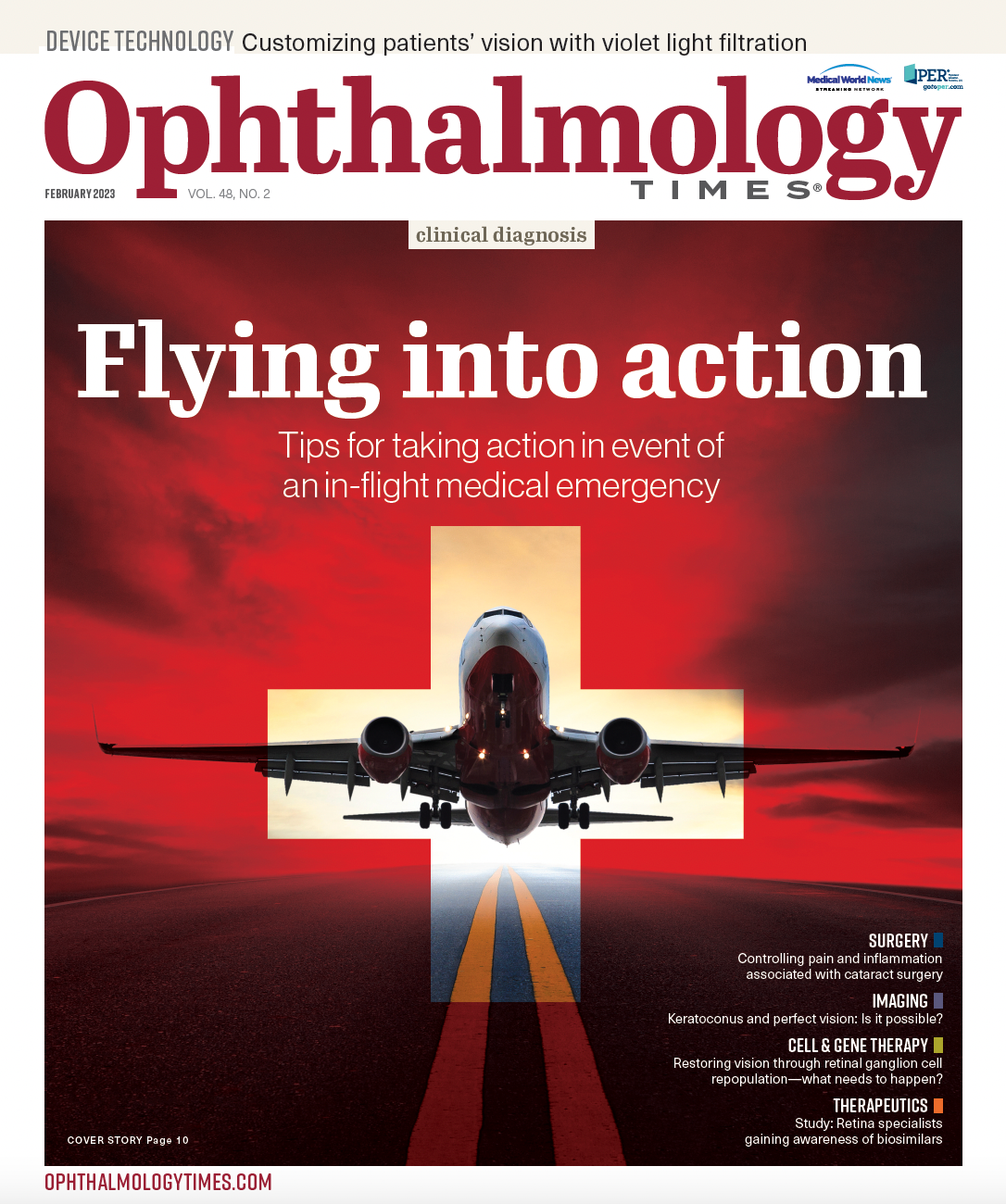Publication
Article
Digital Edition
Examining the present and future of artificial cornea transplantation
Author(s):
According to James Chodosh MD, MPH, some corneal conditions may not be treatable with a transplant.
A major advance in the management of corneal diseases was the development of keratoprosthesis.

Reviewed by James Chodosh MD, MPH
Artificial devices can contribute to restoring vision in cornea-blind patients but will not likely be a panacea for a lack of donor tissue in the area of corneal transplantation, at least not in the immediate future, according to James Chodosh MD, MPH, professor and chairman of the Department of Ophthalmology and Visual Sciences at the University of New Mexico School of Medicine in Albuquerque, New Mexico.
Speaking at the 61st annual Walter Wright symposium, his presentation was titled Artificial Cornea Transplantation: Where are We Now and Where Will We Be in 10 years.
“Donor tissue is going to remain an issue because cultural, religious and economic barriers to donation are not likely to improve in the near future,” he stressed.
Another issue is that some corneal conditions are not suitable for treatment with corneal transplantation, noted Chodosh.
“The challenge is that not all blinding corneal conditions are amenable to corneal allograft, lamellar or otherwise,” he explained.
Moreover, corneal grafting often fails to provide a long-term solution, according to Dr. Chodosh, who cited data from Australia which demonstrated that only 55% of corneal transplants are still clear 15 years after surgery.1 Similarly, a retrospective series demonstrated that only 44 of 86 eyes (51%) had clear grafts after repeated corneal transplantation. Complications such as immune rejection, secondary glaucoma, and cataract occurred. Graft survival at 5 years from surgery fell for the second and third grafts, to 25% and 0%, respectively, compared to the first and second grafts.2
“We know that each corneal graft rejection raises the risk of subsequent graft rejection,” Chodosh said. “With full-thickness keratoplasty, as outlined in Bersudsky’s well-known paper, the third penetrating keratoplasty had very poor survival.”
However, Chodosh explained that no one in their case series made it five years out with a clear cornea.
“And I don't think endothelial keratoplasty will be an exception,” he added. “Yes, rejection will be less common, but repeat endothelial keratoplasty will also prove to be less likely to succeed each time it is repeated.”
A major advance in the management of corneal diseases was the development of keratoprosthesis, Chodosh pointed out.
“It is an artificial device, synthetic or partially synthetic, for replacement of the cornea to provide a clear outer medium for vision,” he said.
Claes Dohlman, MD, PhD, was a pioneer in the development of keratoprosthesis who developed the first Boston keratoprosthesis, Chodosh explained. The Boston keratoprosthesis was approved by the FDA in 1992, but its use was limited to Dr. Dohlman’s clinical practice for the first decade, pointed out Dr. Chodosh, but he noted it use has increased dramatically in the last 20 years.
The original device was “far from perfect” and modifications in the device have been made, explained Dr. Chodosh, citing one specific improvement being that holes were placed in the back plate. Another advance was the use of topical antibiotics to minimize the development of bacterial endophthalmitis following keratoplasty, noted Dr. Chodosh, pointing to results of a retrospective series of 255 eyes with various pre-operative diagnoses.3
“The addition of topical vancomycin, which I still use but not in every patient, had a major impact on the incidence of bacterial infections,” he said.
One study looking at retention of the Boston keratoprosthesis concluded that the keratoprosthesis seemed to be a viable option for eyes that are not candidates for penetrating keratoplasty but that when severe ocular surface disease due to an autoimmune cause was present, the retention rate was lowest.4
However, the keratoprosthesis can be used to great effect in the management of corneal limbal stem cell deficiency, Chodosh opined.
One investigation involving 173 procedures in 149 eyes found no difference in the retention failure rate in eyes with and without limbal stem cell deficiency.5
“Outcomes in the setting of limbal stem cell deficiency were equivalent to outcomes for other indications like graft rejection,” Chodosh said.
The American Academy of Ophthalmology technology group reviewed the literature on the safety and outcomes of the Boston Keratoprosthesis, including nine studies in its review, and endorsed it as an innovation that improves vision in cases of severe corneal opacification not amenable to human cadaveric corneal transplantation, Chodosh pointed out.6
In addition, a systematic review and meta-analysis which compared the Boston Keratoprosthesis to repeat donor keratoplasty for corneal graft failure, found the probability of maintaining a clear graft at five years was 47% with repeat penetrating keratoplasty whereas it was 75% with the Boston Keratoprosthesis.7
Newer designs have emerged such as the Lucia, which provides better cosmesis, and the Flex-Kpro, which has been used in animal models and is still in experimental stages, Chodosh noted. “
“The Boston Keratoprosthesis is not perfect, and we can do better,” he concluded. “But, I am encouraged because new devices are still being developed. It (Boston Keratoprosthesis) has now impacted the lives of over 10,000 patients. His (Dohlman’s) persistent diligence in tackling a seemingly insurmountable problem, corneal blindness, is a model that I think we should all aspire to.”
James Chodosh MD, MPH
P: 617-573-3938
Chodosh is a consultant to Mass General Brigham, a not-for-profit healthcare entity that also markets the Boston Keratoprosthesis.
References
1 Keryn Williams, PhD. Douglas J. Coster, FRACO; The immunobiology of corneal transplantation. Transplantation. 2007 Oct 15;84(7):806-13. Referenced January 2023. doi: 10.1097/01.tp.0000285489.91595.13
2 V Bersudsky, T. Blum-Hareuveni, U Rehaney S Rumelt. The profile of repeated corneal transplantation. Ophthalmology. 2001 Mar;108(3):461-9. Accessed January 2023. doi: 10.1016/s0161-6420(00)00544-3
3 Marlene L. Durand, MD; Claes Dohlman, MD, PhD .Successful prevention of bacterial endophthalmitis in eyes with the Boston keratoprosthesis Cornea. 2009 Sep;28(8):896-901. Accessed January 2023. doi: 10.1097/ICO.0b013e3181983982.
4 Joseph B. Ciolino, MD; et al. Retention of the Boston keratoprosthesis type 1: Multicenter study results. Ophthalmology. 2013 Jun;120(6):1195-200. Accessed January 2023. doi: 10.1016/j.ophtha.2012.11.025.
5 Carolina Aravena, MD; et al. Long-Term Outcomes of the Boston Type I Keratoprosthesis in the Management of Corneal Limbal Stem Cell Deficiency. Cornea. 2016 Sep;35(9):1156-64. Accessed January 2023. doi: 10.1097/ICO.0000000000000933.
6 W. Barry Lee, MD, FACS; Roni M. Shtien, MD, MS; et al. Boston Keratoprosthesis: Outcomes and Complications: A Report by the American Academy of Ophthalmology. Published July 2015. Accessed January 2023. doi: 10.1016/j.ophtha.2015.03.025
7 Sumayya Ahmad, MD, Priya M. Mathews, MD, Kristina Lindsley, MD; et al. Boston Type 1 Keratoprosthesis versus Repeat Donor Keratoplasty for Corneal Graft Failure: A Systematic Review and Meta-analysis. Ophthalmology. 2016 Jan;123(1):165-77.
doi: 10.1016/j.ophtha.2015.09.028. Accessed January 2023.

Newsletter
Don’t miss out—get Ophthalmology Times updates on the latest clinical advancements and expert interviews, straight to your inbox.





